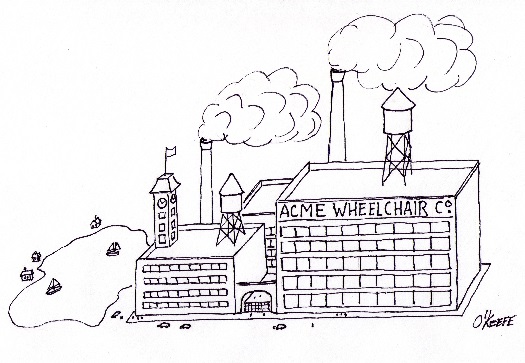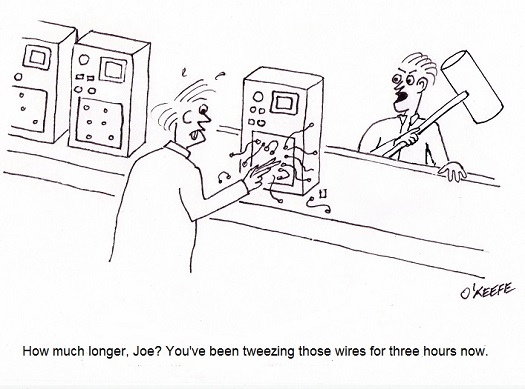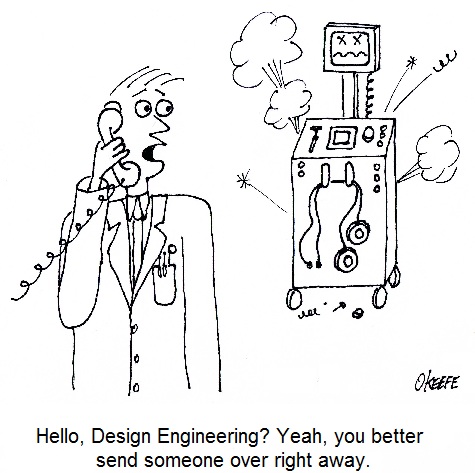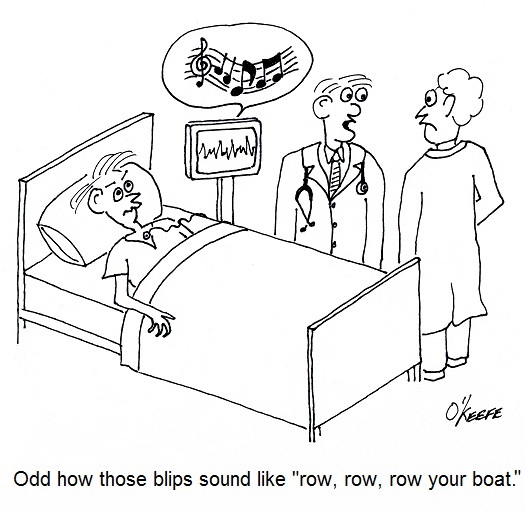|
Who hasn’t finished a project, only to discover that you’d done something wrong and the whole thing would need to be redone? Perhaps you hadn’t checked your work along the way, confident that all would be well in the end. Imagine the costs involved if this scenario were to take place on a commercial production line. The Systems Engineering Approach to things helps ensure this doesn’t happen. Last time we wrapped up our discussion on the Production stage of the systems engineering approach to medical device design, and today we’ll cover the final stage, Utilization. The Utilization stage marks the point at which the medical device has been sold and is in actual use in the marketplace. Despite the fact that the product has at this point undergone many reviews and revisions and a great investment has been made into deciding whether or not to put it into production, changes can still take place in its design. Markets aren’t static, and products may be made to change due to stakeholders’, that is, those with a vested interest, changing requirements, whether those are aimed at further cost reduction, or perhaps to implement innovations to make the product more appealing to end users. Other reasons for change may be initiated by the sales and marketing departments. They keep their fingers on the pulse of consumer trends, and they may want the design modified according to market research and feedback they receive from dealers, service technicians, and end users. For example, the sales staff may have been apprised by end users that the keypad to their electronic muscle stimulating device needs modification. Patients have voiced they would prefer to here a clicking sound when depressing the buttons, in order to receive some auditory feedback. In addition, distributors of the device reported that although the electronic stimulators were functioning as intended, end users didn’t like the feel of the buttons. The lack of tactile feedback often led to confusion because they weren’t sure whether they had depressed the button or not. Another interesting discovery concerning lack of feedback was that product service technicians were reporting premature wearing out of the keypads. Absent the satisfying click sound, users were inclined to push on the pads too strenuously, which drove up warranty service costs. The medical device manufacturer’s stakeholders are always concerned with costs, and increased service costs definitely raise the red flag. Considerations like these typically arise after a medical device enters the Utilization stage. Fortunately, the objective of the systems engineering approach is to ensure that stakeholders’ needs are met in view of ever-changing requirements, even after the device has entered the marketplace. No matter what may happen during the life cycle of a product, the systems engineering approach is used every step of the way, from the Concept stage through to Utilization. That ends our discussion on the systems engineering approach to medical device design. Next time we’ll begin unraveling some of the mysteries and misconceptions behind patenting inventions. ___________________________________________ |
Posts Tagged ‘medical device design’
Systems Engineering In Medical Device Design – Production, Part 4
Sunday, March 17th, 2013|
Did you know that from the early days of the Industrial Revolution until well into the 20th Century it was common practice for all aspects of a product to be built entirely under one roof? For example, a wheelchair manufacturer in the 1890s would buy the various raw materials needed to construct component parts, everything from bars of steel and wooden boards to rattan stalks and gum rubber, then produce every part of the wheelchair in one facility. Items as diverse as chair frames, footrests, wicker seat cushions, springs, wheel rims and spokes, and tires would all be constructed from the raw materials purchased, then assembled into the finished product. Doesn’t sound like an efficient process to you? Henry Ford didn’t think so either. In fact, he is credited with pioneering mass production in manufacturing when he observed during the production process of his line of automobiles that inefficiencies abounded. Inefficiencies in manufacturing are common, as they are in everyday life. Last time we saw how robots, i.e., the introduction of industrial automation, can be used during the Production stage of our systems engineering approach to medical device design to increase efficiency and reduce manufacturing costs. Today we’ll take a look at another inefficient practice, along with its solution. Returning to our wheelchair manufacturer, the problems associated with manufacturing and assembling all aspects of a product are many. At the top of the list is the substantial cash outlay that’s required to buy and maintain a huge factory complex and all the specialized equipment required to make each and every part. In addition, there’s the ongoing expense of employing and training employees needed to fabricate each component. In other words, the wheelchair factory has a lot of fixed overhead expense to carry, and the more overhead there is, the more expensive the end product. Expenses such as these are almost always passed on to the buyer. The solution? Outsourcing. That is, using outside manufacturers to produce many, perhaps even all, of the component parts. Then our wheelchair manufacturer would simply assemble the purchased parts into the finished product, resulting in lower manufacturing costs and higher profits. The benefits of outsourcing were widely recognized in the decades following World War II, when the post-war economy was booming and demand for consumer goods increased dramatically. That ends our look at the Production stage. Next time we’ll move on to the Utilization stage to see how the systems engineering approach is put into play once the medical device has been introduced into the marketplace. ___________________________________________ |
Systems Engineering In Medical Device Design – Production, Part 3
Sunday, March 10th, 2013| When I was a kid I had a toy robot that captured my attention like no other toy. I thought it was so cool to have something animated that looked both humanoid and machine-like at the same time. It couldn’t do much, just walk in a stiff, jerky way and move its arms up and down, but that was enough to keep me fascinated.
Today’s generation of robots do not often take on the humanoid form, but they’re capable of so much more. Robots on assembly lines perform a variety of tasks like welding and placing electronic components on circuit boards, and they do it much more quickly and accurately than any human could, so they’re often employed in manufacturing. We’ve been discussing the Production stage of the systems engineering approach to medical device design. We learned that within the manufacturing process there are often opportunities for cost reduction, and today we’ll see how robots can be used to reach those goals. Last week we presented a sample scenario involving the manufacture of a percussion therapy device. In their quest to reduce manufacturing costs, engineers identified bottlenecks along the assembly line which led to idle worker time and the inability to keep up with orders. In addition to these production woes, it was discovered that the tedious, repetitive manual labor that occurred at each bottleneck created opportunities for assembly mistakes. As many as 30 devices per day were being rejected by quality control inspectors due to issues such as faulty wiring and improper parts usage. This led to expensive rework to correct mistakes. After further evaluation, design engineers determine that bottlenecks can be eliminated by installing automated assembly equipment in the three distinct assembly stages represented on the line, those involving wiring harnesses, printed circuit boards, and the motor drive mechanism. The potential for human error is high during many facets of manufacturing, and this can be minimized or eliminated through the use of robots, that is to say, mechanized equipment capable of automatically performing a complex series of specific tasks. These robots never tire of performing tedious, repetitive work, and their efficiency is unparalleled. Their introduction at key junctures on the assembly line has benefits across the manufacturing process, enabling workers to keep continuously busy and reducing the incidence of human error. The introduction of robotics is known as industrial automation. Robots efficiently increase manufacturing speed, and along with it profits, so their introduction more than compensates for the investment costs associated with purchasing them. Next time we’ll continue our look at the Production stage to discover another way that systems engineering can simplifying the assembly process, by eliminating some functions altogether. ___________________________________________ |
Systems Engineering In Medical Device Design – Preproduction, Part 3
Monday, February 18th, 2013| We’ve been discussing the Preproduction aspect of the Development stage of our systems engineering approach to medical device design. Last week we learned that once the medical devices produced during Preproduction are assembled, they’re subjected to rigorous testing, first in the lab, then in the real world.
Once devices produced in Preproduction pass the test in a controlled laboratory environment, it’s time to place them into field testing. The objective is to place Preproduction devices within actual working environments, such as healthcare facilities. These facilities must be willing to cooperate with design engineers during testing on a number of items, including but not limited to evaluation of product performance and clarity of instructions. In order for this to happen, design engineers must coordinate their efforts with their company’s sales and marketing departments to locate, qualify, and enlist suitable facilities. To qualify, a facility must be able and willing to put enough hours of use onto the test device to effectuate a thorough and complete analysis of its effectiveness. Depending on FDA regulatory requirements and the complexity of the design, field testing could take as little as several months or as long as several years. During field testing valuable data is gathered to enable engineers to evaluate the performance of the Preproduction devices. This data will then be measured up against stakeholder requirements. What this process might entail in a dialysis machine, for example, is that test data is analyzed to make sure all operational parameters fall within the desired range. Data would be derived from measurements of such things as the pressure of blood flowing pre- and post- introduction to the dialyzer. Measurements are dutifully recorded by engineers and field personnel onto data sheets for later evaluation back at the manufacturer’s engineering office. Persons contributing data vary widely, from healthcare facility end users and maintenance personnel, to the medical device dealer’s service technicians. End users also provide feedback to design engineers regarding the field test device’s functionality, effectiveness, reliability, and maintainability. Feedback can include specific information about things like glitches in software, unusual noises, erratic operation, breakdowns, and even difficulties encountered during repairs. If any problems are discovered with the device during lab and field testing, revisions are made. Design engineers and technical writers get back to the drawing board to rework things and find resolutions until all issues have been addressed. Only then is the design presented to stakeholders for final approval. If all goes well, manufacturing will now take over and place the device into full commercial production. We have now concluded our discussion on the Development stage of systems engineering as it relates to medical device design. Next time we’ll move on to the Production stage where we’ll examine post-production concerns. ___________________________________________ |
Systems Engineering In Medical Device Design – Instructions, Part 3
Sunday, January 20th, 2013| Last time we looked at the objective of the quality control department in the Production stage, that being to ensure that the end product produced fits all requirements. We learned that to meet this objective a great deal of collaboration must take place in the Development stage between quality control staff and design engineers in order to produce a complete set of instructions for quality control inspection and testing. Now let’s see how these instructions are developed.
Inspection and test methods are devised by the quality control department to ensure that a completed medical device lives up to its intended use. What good is a diagnostic imaging machine that doesn’t provide accurate internal views of a patient’s body? Or a heart defibrillator that sends electrical energy pulses to a patient’s heart muscles when it’s not supposed to? Quality control instructions are developed to guide inspection and testing methods so they’re performed correctly and consistently during the medical device Production stage. The objective is to catch problems before they occur. For example, it can be specified that the plastic body components of a medical device be visually inspected after they are received from an outside vendor to check for undesirable defects, such as the presence of burrs, cracks, or non-uniform coloration. If anomalies are discovered, they’re documented, and the components are rejected. In other words, they are barred from being used in the assembly process. Quality testing methods are varied. They may involve hooking up the completed medical device to test instruments to simulate all possible modes of operation and any anticipated glitches that may occur during testing. While hooked up, the device’s operation is measured against key parameters to ensure that all is working well, and the data gathered is recorded and analyzed to see if operation is within normal limits. For example, an electric multimeter could be connected to the power cord of the device to measure how much electrical current is being drawn from the wall outlet during operation. If current drawn is too high, it may be indicative of a defective electrical component, and an in depth examination would follow. Generally speaking, if test measurement parameters do not fall within acceptable limits as determined by previously established stakeholder requirements, then the medical device will be rejected by quality control. It will then be sent back to the manufacturing department, along with a detailed inspection and test report explaining why it was rejected. At this point the rejected device is either reworked or disposed of entirely. Next time we’ll continue our discussion on the development of instructions for the Utilization stage, the stage where the medical device is actually put into use by the end user. ___________________________________________ |
Systems Engineering In Medical Device Design – Instructions, Part 2
Monday, January 14th, 2013| Last time we discovered that clearly written instructions are one of the desired end results of the Development stage of the systems engineering approach to medical device design. We learned that one of the objectives of these instructions is to make sure the devices are manufactured in a cost effective manner and with minimal defects during the Production stage.
Other instructions created during the Development stage are those addressing quality control inspections and testing instructions. The objective of the quality control department is to ensure that, during the Production stage, the end product has been assembled correctly, making use of the prescribed parts, and absent manufacturing defects. This end is achieved by virtue of the fact that the quality control department staff is usually not under the management of the engineering or manufacturing departments, therefore they are positioned to offer an impartial assessment of the production process. An undesirable side effect of quality control’s impartiality is that because they are not intimately involved in the design process, a great deal of collaboration must take place between them and design engineers to produce quality control instructions which meet objectives. To this end, many discussions must take place concerning subject matters as diverse as requirements for component dimensions, component material properties, and the proper assembly of parts. Next time we’ll continue our discussion on the Development stage by further examining how instructions are developed to ensure that the quality control department meets its objectives while performing inspections and tests during the Production stage. ___________________________________________ |













